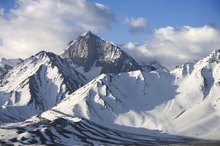What Is the Max Altitude at Which a Person Can Breathe?
As humans ascend higher into the atmosphere, air density declines. While air composition remains similar, the drop in air pressure, and in return, air volume, effectively makes the respiratory system work much harder in order to supply the same levels of oxygen to the blood stream. In cases where it is impossible to provide similar levels of oxygen to the body, a host of health complications arise, which can potentially result in death.
The Death Zone
Used to describe high danger altitude on the Mount Everest ascent, the "Death Zone" begins at about 8,000 meters or 26,246 feet 3. At this elevation, unassisted from compressed air or oxygen, severe altitude sickness sets in, debilitating the human body and eventually resulting in death 1. The low density of air at this altitude makes acclimation impossible. Cold temperatures and weather conditions at this altitude also affect the high mortality rate of climbers.
- Used to describe high danger altitude on the Mount Everest ascent, the "Death Zone" begins at about 8,000 meters or 26,246 feet 3.
- Cold temperatures and weather conditions at this altitude also affect the high mortality rate of climbers.
Altitude Sickness
Causes of Low Blood Oxygen Levels
Learn More
Also known as "mountain sickness," altitude sickness describes the two conditions of high altitude cerebral edema, or HACE, and high altitude pulmonary edema, or HAPE 1. HAPE describes a condition caused by a shortage of oxygen in the body, which eventually leads to a build-up of fluid in the lungs. HACE is a similar condition, except that the fluid builds up on the brain and causes it to swell. Hyperventilation, along with general fatigue and cyanosis accompany HAPE. HACE causes a host of problems such as headache, vomiting, fatigue, hallucination and other temporary neurological problems which can lead to death after prolonged exposure.
- Also known as "mountain sickness," altitude sickness describes the two conditions of high altitude cerebral edema, or HACE, and high altitude pulmonary edema, or HAPE 1.
- HACE is a similar condition, except that the fluid builds up on the brain and causes it to swell.
Altitude Acclimatization
Altitude sickness is known to set in at heights as little as 2500 meters or 8,000 feet 1. However, many people still climb and hike through high mountains, participate in sports, or even live in very high elevations. People who live at sea-level do this through acclimatization. This is a process in which one slowly introduces themselves to higher altitudes in order to let their body adjust to the decreased air pressure and decreased oxygen intake.
- Altitude sickness is known to set in at heights as little as 2500 meters or 8,000 feet 1.
- However, many people still climb and hike through high mountains, participate in sports, or even live in very high elevations.
Adaptation
What Is the Vertical Limit in Mountain Climbing?
Learn More
While those born and raised at or near sea level have trouble performing and even adapting their bodies to high-altitude conditions, there are people who have lived their whole lives in such areas 4. The people of Nepal, Tibet, Peru and Bolivia for example, have adapted genetically to living in high-altitude conditions. Native Peruvians and Bolivians have adapted their bodies to produce more hemoglobin in their blood, effectively increasing the capacity of their lungs. The Tibetans and Nepalese have adapted to breathe quicker, and also have larger arteries and capillaries to carry blood throughout their body.
- While those born and raised at or near sea level have trouble performing and even adapting their bodies to high-altitude conditions, there are people who have lived their whole lives in such areas 4.
- The Tibetans and Nepalese have adapted to breathe quicker, and also have larger arteries and capillaries to carry blood throughout their body.
Related Articles
References
- Altitude.org: Altitude Sickness
- The Age.com: "The Deadly Business of Climbing Everest"; Connie Levett; 2006
- PBS: "Everest: The Death Zone"; 1998
- Luks AM, Swenson ER, Bärtsch P. Acute high-altitude sickness. Eur Respir Rev. 2017;26(143) doi:10.1183/16000617.0096-2016
- Hifumi T, Kondo Y, Shimizu K, Miyake Y. Heat stroke. J Intensive Care. 2018;6:30. doi:10.1186/s40560-018-0298-4
- Bergeron MF. Heat cramps: fluid and electrolyte challenges during tennis in the heat. J Sci Med Sport. 2003;6(1):19-27.
- Guerra KC, Crane JS. Sunburn. [Updated 2018 Nov 23]. In: StatPearls [Internet]. Treasure Island (FL): StatPearls Publishing; 2019 Jan-.
- Meier D, Collet TH, Locatelli I, et al. Does This Patient Have Acute Mountain Sickness?: The Rational Clinical Examination Systematic Review. JAMA. 2017;318(18):1810-1819. doi:10.1001/jama.2017.16192
- Paralikar SJ. High altitude pulmonary edema-clinical features, pathophysiology, prevention and treatment. Indian J Occup Environ Med. 2012;16(2):59-62. doi:10.4103/0019-5278.107066
- Harvard Health Publishing. Into thin air: Medical problems at new heights. Harvard Health.
Writer Bio
Marcus Scott has been writing on international politics, local news and culture since 2004. He has written articles, op-eds, columns and edited for student organization presses and blogs, including the Roosevelt Institution Defense and Diplomacy blog. In 2005 and 2006 Scott attended the Journalism Education Association national conferences. He earned his Bachelor of Arts in international relations from the University of California, Davis.









